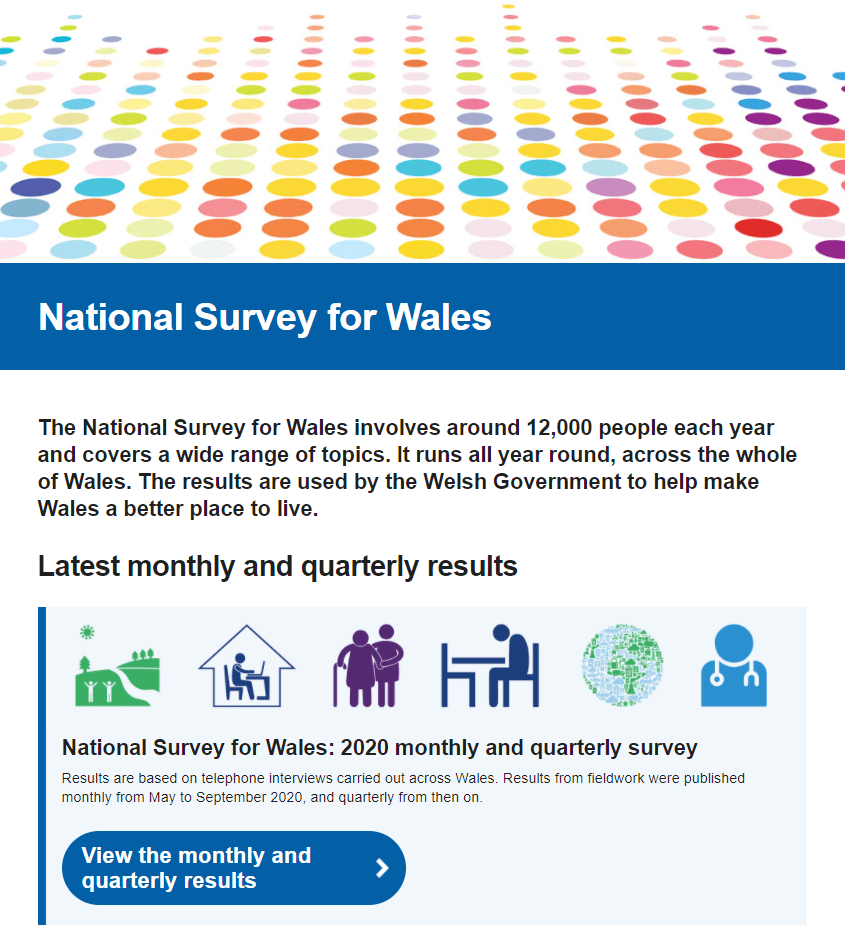Darllenwch y dudalen hon yn Cymraeg
The National Survey for Wales is the main social survey carried out by Welsh Government and its partners. It involves around 12,000 people across Wales each year, and in normal times it’s based on interviewing people in their homes. The survey covers many different topics, from health and the NHS to schools, council services, and views about the local area.
In this blog we’ll discuss how COVID-19 has affected the way we have carried out the survey over the past year, and how we’re looking at doing things for the future.
As with so many other things, in March 2020 we had to change the way the survey was done. Almost immediately it was clear we would have to stop fieldwork because going out to people’s houses was not possible or safe. But with people’s lives and circumstances changing quickly, the information gathered by the survey was more valuable than ever to help track these changes and inform decisions. With this in mind, we redesigned the survey in record time so it could be carried out by telephone. We cut the length from 45 to 25 minutes, altered most of the pre-existing questions, and added many new questions to understand more about the difficulties people were facing.
Visiting people at home to encourage them to take part is usually a vital step in making sure the survey is representative (and not biased towards people with more time, or who just enjoy doing surveys!). So, we decided to carry out the telephone survey by recontacting people who had already taken part in the face-to-face survey.
After a busy few weeks, the survey was up and running again in late April 2020. We were pleased with this achievement, which was also made possible by the hard work of our partners in the Office for National Statistics who run the survey for us. Based on previous similar surveys, we expected that around a quarter of the people approached would take part, but in fact almost three quarters did. This was no doubt partly because some people were less busy than usual, but it also showed that people understood why the survey information was needed and wanted to help.
The other major change we made was to how often we update the survey topics and publish results. Previously we’d only done this once a year, but given the fast-changing situation we decided to revise the topics every month and also to publish results once a month. The first results were published in June 2020, and have since fed into media briefings and policy decision-making throughout the crisis.

As things have settled down, we’ve now moved to quarterly updating and reporting. And from January 2021, we have started to sample new people to take part in the survey, rather than recontacting previous respondents. The survey is still carried out by telephone but interviewers now make socially-distanced visits to addresses to encourage people to take part; this means we still have a good response rate, and robust results.
What about the future?
The pandemic has accelerated the rate of change in how surveys are carried out, with some surveys moving to telephone and some to online, and many people making far more use of digital services and ways of communicating online. And of course the Census has just been carried out online-first for the first time ever. We’re keen to make use of all the learning from this while still making sure the survey results are robust. So, during 2021 we will also be trialling an online section of the survey, for people to complete themselves after the telephone interview, and thinking about how to make the best use of online methods in future years.

There’s lots more information about the National Survey on our web pages, or just get in touch with us at surveys@gov.wales if you’d like to know more.
Stephanie Howarth
Chief Statistician